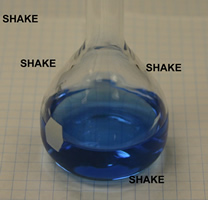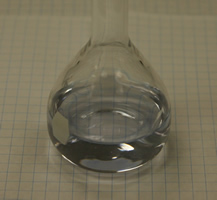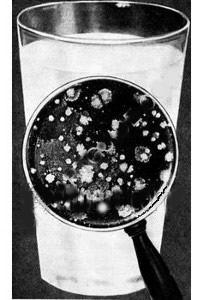" Feeling Blue"
The Oxidation and Reduction of Methylene Blue
SED 695B; Fall 2005
Overview:
Sometimes when our lives get "shaken" up, we can feel a little blue. After a short time we begin to feel like our normal selves.
This demonstration provides a visual of how, after a little shaking, the "blues" can come and go from our lives just like a flask with methylene blue.

Standards Addressed:
CHEMISTRY
Conservation of Matter and Stoichiometry
3. a. Students know how to describe chemical reactions by writing balanced equations.
3. g. Students know how to identify reactions that involve oxidation and reduction and how to balance oxidation-reduction reactions.
Experiment
- Potassium Hydroxide Solution
- Dextrose (Glucose) Solution
- Methylene Blue Solution
- 100 ml Graduated Cylinder
- 500 ml volumetric or Erlenmeyer Flask with Stopper
- Safety Equipment: chemical resistant gloves; chemical resistant aprons; and splash goggles
Procedure:
- Using the graduated cylinder, measure out 100 ml of potassium hydroxide solution into the flask
- Measure out 100 ml of dextrose solution and add to the same flask
- Add 3-4 drops of methylene blue to the flask
- Stopper the flask and swirl to mix the solutions
- Allow the solution to stand undisturbed until it turns colorless
- Shake the flask gently again to turn the solution blue
- Let the flask sit until it turns colorless
- The process of shaking to obtain the blue color can be repeated about 10 times
Safety Precautions:
- Potassium hydroxide is corrosive; contact with skin causes severe blisters; very harmful if swallowed; extremely dangerous to eyes
- Wear a chemical-resistant apron; chemical-resistant gloves and chemical splash goggles
Disposal:
Neutralize the resulting solution according to Flinn Suggested Disposal Method #10 for Bases, Strong and Weak, and Basic Anhydrides. Bases should be neutralized by a mild process of diluting to 1 M or 10% and neutralizing with dilute hydrochloric acid to pH of 5-9 before discharge to the drain. The procedure can be found in the current Flinn Chemical Catalog/Reference Manual
Questions:
As the students observe the reaction in the flask turn from blue to colorless, and then back to blue when shaken, have them write down the ingredients.
Potassium hydroxide, dextrose, methylene blue and oxygen "shaken" into the liquid.
1) What are the possible reactions?
2) Does the amount of shaking affect the length of time for the solution to turn colorless?
3) In the dairy industry the dye reduction test using methylene blue can determine whether or not milk is classified as “excellent”,”good”, “fair” or “poor” based upon the rate at which the solution turns colorless (the faster the milk turns from blue to clear, the poorer the rating.) How does this work?
Answers:
1) In a series of quick reactions, glucose (which is alkaline) is converted into glucoside, and oxygen gas in the flask is shaken into solution. The dissolved oxygen oxidizes the methylene blue (which begins colorless when reduced) turning it blue (oxidized). Then, slowly the blue colored oxidized methylene blue is reduced by the glucoside and the solution turns back to colorless.
See the series of equations and pictures below.






2) The amount of shaking is directly proportional to the length of time the solution stays blue.
3) The removal of the oxygen from milk during bacterial metabolism causes the oxidized methylene blue color to disappear. The more bacteria, the quicker the milk changes to clear and the poorer the quality of milk. Factors affecting the rate of bacterial metabolism in milk include: type of bacteria; temperature of the incubating milk (cold temperature holds more oxygen and warm temperature facilitates bacterial growth); amount of oxygen in the milk (the milking process or pouring the milk can add oxygen to the solution); and the presence of light will cause the reduction to go more quickly.

References & Links:
Flinn Scientific
http://www.flinnsci.com/Sections/Safety/safety.asp
http://www.flinnsci.com/Sections/Chemistry/chemistry.asp
Dye Reduction Tests In Milk
http://www.foodsci.uoguelph.ca/dairyedu/resazurin.html
Journal of Chemical Education "The Blue Bottle"
http://jchemed.chem.wisc.edu/Journal/Issues/1997/Apr/abs402.html